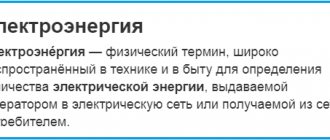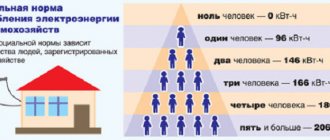Important information
The social consumption rate applies to those subscribers who have not yet installed metering devices in their homes.
This is not always due to people's reluctance to install a meter. In some cases, it may not be technically possible to do this: for example, in dilapidated and dilapidated houses. The impossibility of installing equipment must be documented (inspection report). Important: if a person simply does not want to install an electric meter, then increasing coefficients will be used when calculating the cost of the service. For such subscribers, the electricity fee will increase every year. But there are other situations when the calculation will be carried out using this indicator:
- the meter has become unusable;
- the meter has expired;
- apartment residents do not transmit meter readings to the management company and do not allow a representative of the management company to check the meter;
- intentional damage to equipment.
Definition of concepts: what is the social norm for electricity
This is a certain value of electricity consumption calculated for one person. The establishment of the value of the social norm is carried out by each region of the country individually. After its introduction, it is planned to approve two different tariffs for paying for the service:
- within the limits established by the state;
- payment for volumes exceeding this limit.
The tariff accepted for payment of expenses in excess of the limit will be higher than that applied when calculating within the limits of the standards.
Why is the indicator needed?
This is necessary so that the state receives leverage to encourage the population to save light.
And those individuals who do not intend to reduce energy consumption will be forced to pay for the service at a higher cost - approximately at the level of small businesses. The use of these standards will reduce “cross-financing”. What does this mean: a private consumer receives a service at a lower price due to the fact that industrial consumers use energy resources at an inflated cost. Now ordinary citizens pay 1.5-2 times less for energy supplies than businessmen and industrialists.
How to calculate using the formula how much you are supposed to pay per month
In order to calculate the payment for electricity, you must use the following formula:
S = K*N*T
The following indicators are substituted into the formula:
| S | Amount paid without metering device |
| K | The total number of people in the family. Only those citizens who are registered in the premises are taken into account |
| N | Current regional indicator |
| T | Tariff for 1 kW |
If you do not use additional powerful equipment, then you can meet the standard established by the Government.
If a citizen consumes more energy than indicated in legal documents, he will have to overpay at a higher tariff.
There is only one way to avoid this - by installing an electricity meter. This will allow you to pay only as you consume.
There are additional conditions that should be taken into account when determining the payment amount:
| If a single pensioner lives in the apartment | In the first year after registration, he only needs to pay at a reduced rate, but from the next year, payment is made according to the current social norm |
| Persons living in the village | They pay at a tariff of 90 kW |
| If the apartment has a stove | Per person consumption rate is 43 kW |
After the meter is installed, payment will occur in full accordance with the data shown by the device.
These indicators should be written down no more than once a month, immediately before repaying the resulting monthly debt.
Video: on this topic
Indicator size
Now the rate of electricity consumption is determined by each region independently.
This indicator was previously introduced only in some regions of the Russian Federation. Now it is used throughout Russia.
So, for example, in Moscow, the rate of electricity consumption per person per month, provided that a gas stove is used, is 80 kWh, in St. Petersburg - 78 kWh, in the Perm Territory - 50 kWh, in the Nizhny Novgorod Region - 50 kWh
Important: in the constituent entities of the Russian Federation, changes to the generally accepted meaning are allowed.
Standard electricity consumption per person without a meter in 2022
The minimum flow rate is not averaged across the country, but depends on the region, the climatic conditions a person lives in, and the length of daylight hours in that area. However, there are other indicators that are taken into account. These include:
- number of storeys of the building;
- housing size;
- the material from which the building is constructed;
- location of housing - in a city or rural area;
- the number of people registered in the apartment;
- number of rooms in the apartment;
- availability of an elevator and fire-fighting equipment;
- year of construction of the residential building;
- presence of an electric stove.
Electricity consumption by region
Adopted at the legislative level. The indicators depend on what equipment and household appliances are used in the apartment.
| Name of the locality | Consumption rate, kW | |
| gas stove | electric stove | |
| Saint Petersburg | 78 | 111 |
| Transbaikalia | 65 | 96 |
| Novosibirsk | 156 | 213 |
| Vladimir region | 50 | 90 |
| Permian | 185 | 263 |
| Rostov region | 96 | 156 |
It is worth paying attention: the established parameters are less than the social norm. This is done so that Russians are motivated to save light.
Rostov region
This region has its own indicators. In gasified houses, the standard (kW/hour) is:
- for one person - 132;
- on the second - 82;
- on the third - 63;
- on the fourth - 51;
- on the fifth and subsequent ones - 44.
For residential premises where electric stoves are used, special surcharges are provided. Their value is 50 kW/h per person and 90 kW/h for private households.
If houses use electric water heaters, the premium will be 300 kW/h per person.
Seasonal allowances are also provided in this area:
- For the summer months, a coefficient of 1.1 is accepted;
- In February, March and April, subscribers will make payments taking into account the coefficient of 0.9.
Preferential categories of persons pay at a reduced rate. Beneficiaries include:
- citizens of retirement age;
- families raising a disabled child;
- families with disabled people;
- large families;
- citizens raising adopted children.
A caveat: the unused amount of electricity is not carried over to a future reporting period.
Oryol Region
The standard is fixed at an acceptable level - 190 kW/hour for one person, 50 kW/hour is added for the second, 20 kW/hour for the third and fourth.
But if five or more persons are registered in a residential building, then each family member is entitled to an additional 110 kW/hour. The use of additional electrical equipment in an apartment or house will lead to an increase in the amount of energy consumed. In this case, an additional 3000 kW/hour is added per household with an electric boiler during the heating season, 90 kW/hour per person for households with electric stoves, and 100 kW/hour per person for households with electric water heating.
There are also preferential categories of the population, the social norm for which increases by 1.5 times. These include:
- old age or disability pensioners living alone;
- families consisting only of pensioners;
- large families;
- families with disabled people or disabled children;
- substitute families in which children left without parental care live.
Moscow
Moscow has established special energy consumption standards: 50 kW/hour per person in households with gas stoves, and 80 kW for homes with electric stoves.
For the Moscow region these values will be 94 and 144 kW/hour, respectively.
Important: residents of apartment buildings pay not only for their personal use of electricity, but also for general household needs. This fee is mandatory for all subscribers and does not depend on whether the apartment has a meter or not. The amount of payment will depend on the space occupied.
Payment methods
The formula for calculating electricity depends on whether an individual metering device (IMU) is installed in the apartment or not, and what charging system is used. In addition to individual consumption, utility bills include the cost of electricity costs for general household needs (GDN).
According to the electricity meter
The simplest and most understandable way to calculate the cost of energy consumption is based on the readings of the electric meter.
- The calculation formula for the single-rate system looks like this:
Example 1. According to IPU data for August 2022, 239 kW was consumed. The apartment has a gas stove. The cost of a kilowatt in the region is 5.38 rubles. Then the cost of providing the resource is:
239 * 5.38 = 1285.82 rubles.
- The formula for calculating electricity consumption using a two-tariff meter is a little more complicated:
Example 2. According to the two-tariff electricity meter for August 2017, energy consumption was 239 kilowatts, of which from 7 to 23 o'clock - 167, from 23 to 7 o'clock - 72. The apartment has gas equipment. The electricity supply tariff differentiated by two zones of the day is 4.19 and 2.92 rubles/kW, respectively. Then the cost of the service is:
167 * 6.19 + 72 * 1.79 = 1162.61 rubles.
- You can calculate the amount for electricity using a multi-tariff meter using the formula:
Example 3. According to a multi-tariff meter for August 2022, energy consumption in an apartment with a gas stove was 239 kilowatts, of which: peak zone - 120, half-peak - 47, night - 72. The cost of a kilowatt in the peak zone - 6.46 rubles, half-peak – 5.38, night – 1.79. The total amount is:
120 * 6.46 + 47 * 5.38 + 72 * 1.79 = 1156.94 rub.
According to the data in the examples, it turned out that the multi-tariff calculation method turned out to be the most profitable. The consumer can determine for himself which system will bring savings specifically for him. To do this, you need to find out the approximate power consumption for each zone of the day and multiply it by the current tariffs.
Payment taking into account the social norm of consumption
In 2012, Decree of the Government of the Russian Federation No. 1650-r was approved, which proposes a project for the transition to a system for calculating utility bills taking into account the social norm of consumption. Currently, the system operates in a number of regions of the country (Rostov, Nizhny Novgorod and other regions).
The rate of electricity consumption depends on the number of residents, season, type of heating and stove, location of housing (city or village). The system has 2 tariffs: one for payment for electricity within the social norm, the other for consumption above the norm.
The calculation formula is as follows:
Example 4. Three people live in an apartment located in Rostov-on-Don. Over the course of a month, the family consumed 243 kilowatts of electricity according to the meter. The social norm is set at 196 kW. The rate is within the social norm - 3.72, above the norm - 5.19 rubles / kW. Then the amount for electricity consumption will be:
196 * 3.72 + (243 -196) * 5.19 = 973.06 rub.
The system promotes economical consumption of resources. It also applies in cases of payment by day zones.
Without electricity meter data
Depending on the reasons why there are no electricity meter readings, the calculation formula will be different.
- The meter is missing or readings have not been transmitted for more than 6 months. The cost of resource consumption will be calculated using the formula:
The consumption rate depends on the type of stove installed in the apartment, the number of rooms and the number of residents.
Example 5. A family of two is registered in a two-room apartment with an installed electric stove. There is no electricity meter, although there is the possibility of installing one. The consumption standard for 1 person is 117 kW. The established tariff is 4.04 rubles/kW. The cost of the resource consumed will be:
2 * 117 * 4.04 * 1.6 = 1512.58 rub.
This calculation system is beneficial when more people live in an apartment than are registered. The absence of any resource consumer is documented.
- The meter readings were not transmitted on time or it is faulty.
In such situations, the average energy consumption over the last six months, and in some cases over the last three, is considered.
The cost of electricity is calculated using the formula:
Example 6. The consumer is overdue for meter readings. The apartment has an electric stove. Over the past six months, electricity consumption according to the transmitted readings was: March - 167, April - 185, May - 160, June - 179, July - 159, August - 173 kilowatts. Tariff – 4.04 rubles/kW. The amount to be paid is:
((167 + 185 + 160 + 179 + 159 + 173) / 6) * 4.04 = 686.82 rub.
Paying for electricity by meter will bring savings to the consumer. If it is possible to install an IPU, it is better to install it.
How can you reduce consumption?
To pay less for light, just follow a few simple recommendations:
- replace simple incandescent lamps in housing with energy-saving ones;
- When choosing household appliances, you need to pay attention to its energy consumption class. The most economical would be A or A+++;
- do not turn on the air conditioner with the windows open - this will require more time to cool or heat the room, and, consequently, energy consumption will increase;
- When using an air conditioner, when selecting an operating mode, make sure that the difference between the temperature readings inside and outside is not significant. For example, setting the cooling temperature to 16 °C when the outside temperature is 40 °C or higher would not be a very rational solution;
- It is better to install cooling units (refrigerators, household freezers) where they will receive a minimum of sunlight and heat;
- When using an electric kettle, promptly remove any scale that has formed from it. Otherwise, the water heating time will increase, which means the electricity consumption will increase.
If you follow these recommendations, you will be able to save up to 30-40% of your electricity consumption.
The procedure for calculating the social norm for electricity
The amount of payment for energy consumption is calculated using the formula:
V = Vg/12*P, where
- Vg is the volume of actual annual consumption of electrical energy;
- P is the number of citizens registered in households.
People living in private households pay for electricity at a different rate. This applies to those buildings where there are no meters. The amount of payment for them will depend on how many people are registered in this premises. The consumption rate for such households is adopted separately by regions; it is slightly higher.
Electricity meter readings: how to get data from the device
Electricity consumers are required to pay in full for consumed electricity. To do this, they must transfer the electricity meter readings to the appropriate authority or perform an independent calculation of energy consumption.
Data on consumed energy must be transferred to the energy sales service
How to take readings from induction type electricity meters
Induction-type devices are equipped with a rotating wheel located under a frame with numbers. This data is necessary to perform calculations and transmit readings. The type of electricity meter readings that need to be transmitted depends on the device model and the number of digital values.
Most often, the induction type meter display displays from 5 to 7 digits. The last digit is distinguished from the total number by a difference in size, color, or decimal point. In rare cases, the last two numbers may be highlighted.
When taking readings from the electricity meter, the numerical values after the decimal point are not taken into account. These data display hundredths and tenths of a kilowatt, so they are not taken into account.
Taking readings from an induction electricity meter
How to take electricity meter readings correctly
After installing or replacing an electric meter in a private house or apartment, the owner is issued a certificate confirming the correct implementation of this procedure. The document records the initial digital values. To obtain data from the unit, you need to transfer onto paper all the numbers displayed by the device at the moment, not taking into account the numbers after the decimal point. Also, zeros preceding the first significant number are not taken into account, i.e. 1 or more.
To carry out calculations, you will need data for the previous month. In the first month after installation of the equipment, these figures are taken from the report. Next, you will have to keep a logbook or save all receipts in order to record the indicators.
Some subscription services relieve electricity consumers from having to make their own payments. It is only required to transmit data in a timely manner for a certain period of time. This became possible thanks to an automated system, which itself or through an operator enters data into the personal account, calculates charges and generates a receipt. In this case, the consumer will only have to make payment based on the invoice.
In addition to data on energy used, electronic meters can show other information
How to calculate payment based on electricity meter readings
You can calculate the amount to pay your electricity bills yourself. To do this, you need to subtract the latest data from the previous readings. The result is the amount of electrical energy consumed over the last period of time. All that remains is to multiply it by the current tariff.
For example, if the meter displays a numerical value of 5204 kW, and the previous figure was 4954 kW, the calculations will be as follows: 5204 – 4954 = 250 kW (electricity consumption).
When resetting the counters, the readings are rewritten taking into account all zeros, and “1” is placed at the beginning of the number
However, the values after the decimal point do not need to be taken into account. For example, if the meter displays 00001.7 kW, you need to rewrite this value as 100001
Previous readings are subtracted from this indicator, and the result is multiplied by the tariff. This calculation method is used once, after which readings are taken according to the usual system - without leading zeros and an additional “1”.
When reading data from the meter, the last one or two digits are not taken into account
Allowances
Citizens who live in premises equipped with electric stoves and water heaters rather than gas stoves are entitled to a premium.
The same applies to Russians living in rural areas - they will also receive an additional amount of electricity. The amount of the premium is set at the regional level. The amount of additional volume (using the example of the Leningrad region) is:
- in houses with electric stoves - 50 kW/hour per person;
- for residential buildings not equipped with electric stoves for cooking - 606 kW/hour;
- Payment for energy supply at dachas occurs according to the standards adopted for one person;
- in houses heated by electricity (with installed meters) - an additional 1000 kW/hour.
Definition of consumption
To simply account for electricity consumption, you need to take the data from the readings of the electricity meter assigned to your facility, subtract the readings from the previous month from them and obtain data on consumption as a whole. The obtained data on consumed kilowatt-hours must be multiplied by the rate for 1 kilowatt in the consumer’s region.
If there is no meter, we turn to the Decree of the Government of the Russian Federation “On the provision of utility services to owners and users of premises in apartment buildings and residential buildings” dated May 6, 2011 No. 354 in the current version.
In this document, Appendix No. 2, paragraph 4a, contains the formula for calculating electricity consumption for apartments and houses not equipped with metering devices. The number of citizens living in the apartment, the consumption standard and the tariff for the utility resource are taken into account. If it is technically possible to install a meter, but is not installed, then a correction factor is added to the calculations. No tags for this post.
Average consumption data for household electrical appliances
In order to have an idea of whether it is possible to “fit” into the social norm, you need to know how much electricity is “used” to use a particular household electrical appliance.
| Name of household electrical appliance | Electricity consumption, kW/hour |
| Fridge | 30-40 |
| Computer | 30 and above |
| TV | from 7.5 |
| Washing machine | 25 and above |
| Vacuum cleaner | 4 |
| Iron | 15 |
| Hairdryer | 12,5 |
| Electric kettle | 10 |
| Room lighting | 90 |
| Dishwasher | 24 |
| Microwave | 5 |
News
The application of standards is based on Decree of the Government of the Russian Federation No. 614 of 2013. That is, this initiative is not an innovation. In subsequent years, the principle of establishing the norm changed. The final result of calculating the consumption rate should take into account:
- the amount of electricity consumed monthly, which meets the basic needs of the residents of the house or apartment;
- for this quantity the cost per unit will be set lower than for the amount exceeding this volume.
Download for viewing and printing:
Decree of the Government of the Russian Federation dated July 22, 2013 No. 614 “On the procedure for establishing and applying the social norm for the consumption of electrical energy (power) and on introducing amendments to certain acts of the Government of the Russian Federation on the establishment and application of the social norm for the consumption of electrical energy ( power)"
Are social standards for electricity consumption in force today?
At the end of January 2022, the project of using social standards when paying for electricity was again frozen indefinitely. This decision was announced by a representative of Dmitry Kozak (Deputy Chairman of the Government of the Russian Federation).
Are there any plans for further legislative regulation of the issue?
In the future, officials may return to this issue. However, in order for the introduction of a differentiated tariff to become possible, several conditions must be met:
- determine what the real financial consequences of introducing an innovation will be for ordinary Russians;
- take into account the real incomes of citizens.
Other ways to reduce cross-subsidization that are not associated with an increase in the financial burden on the Russian population are currently being discussed.
Be that as it may, saving resources is still recommended. This will not only have a positive impact on the environment, but will also reduce personal costs associated with paying for utilities.
In Moscow, courts refuse to pay for electricity according to the standard
Here, for example, is how the decision of the judge of court district No. 107 of the Zyablikovo district of Moscow (June 2015) was motivated, supporting Mosenergsobyt, which refused to charge electricity in an apartment without a meter according to the standard:
... The court proceeds from the fact that ... the law establishes three methods of charging for consumed electricity: firstly, in accordance with the readings of the meter, secondly, based on calculations based on the average monthly volume of consumption and, thirdly, according to the consumption standard. Consequently, in the event of a malfunction of the meter and the absence of a consumption standard established in a constituent entity of the Russian Federation, the basis for charging for consumed electricity is the calculation of the average monthly volume of consumption...
The courts still adhere to a similar position. Some time ago one of the visitors asked the question:
In March 2022, the meter burned out. I wrote several applications to Mosenergosbyt demanding that calculations be made according to the standard. At first they began to calculate 2 times less (after the end of the 3-month period for calculating average consumption). However, in 2022 they recalculated and again calculated according to average consumption. He filed a lawsuit with the magistrate at the end of 2022 with a demand to oblige Mosenergosbyt to recalculate according to the standard. However, the court refused this request, citing the fact that the current Moscow Government Resolution No. 1161 dated December 20, 1994 establishes the standard for electricity consumption used in calculating subsidies, and not directly the standard for electricity consumption for the population, and the current tariffs are established by orders of the Department of Economic Policy and development of the city of Moscow 212-TR and 232-TR. Does it make sense to appeal this decision in subsequent instances?
Unfortunately, the answer, apparently, will be: no, it doesn’t make sense. In this situation, the Moscow authorities are to blame for not bothering to adopt the necessary regulatory document. As for Mosenergsbyt, it simply does not have the opportunity to apply the calculation of electricity charges according to standards due to their absence.
An appeal directly to the Moscow government would have some chance of success. After all, it is the authorities of the subject of the Russian Federation, according to paragraph 1 of Art. 157 of the Housing Code of the Russian Federation are required to establish standards by which payments for utility services are calculated in the absence of metering devices. In this regard, it would seem legitimate to require the metropolitan government to compensate for the damage incurred due to its failure to fulfill its obligations to set standards.
However, so far there has been no information about claims of this kind being considered in courts.











